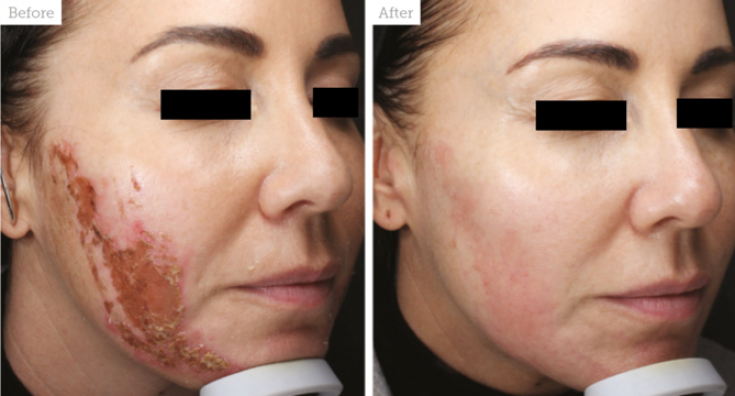Chemical peels, subject to all safety rules during the procedure, are an effective tool in the hands of a cosmetologist, allowing to solve the problems of hyper-hypepigmentation, post-acne scars, reduce wrinkle expression and improve the overall appearance of the skin. However, if the protocol is not followed or the practitioner makes a mistake, the risk of burns, hyperpigmentation, infection, scarring, and other complications increases. This article estet-portal.com describes a case from the practice of Dr. Sherina Balaratnam (Sherina Balaratnam): treatment of a burn after a chemical peel.
- Patient's story of a chemical peel burn
- First Degree Burn Treatment Plan After Chemical Peel
- Results of burn treatment after chemical peel
Patient's story of a chemical peel burn
Patient, 44 years old, had previously undergone several skin care procedures at the author's clinic. A woman went to the doctor with a burn on her face after undergoing a chemical peel at another clinic. Since Dr. Balaratnam was at the training at the time of the patient's request, the initial assessment of the degree of damage was carried out according to the photo provided by the patient. The author recommended that the patient wash the affected area with plenty of cold water and Vaseline to moisten and cool the wound, and then immediately go to the emergency department.
Follow us on Instagram!
Four days later, the patient came to see Dr. Balaratnam, who, during the examination, found that the patient had not sought professional help.
The affected area of the skin was covered with cracks and crusts, the patient was diagnosed with first degree burn. The author advised the victim to go to the burn unit, but the patient, taking into account the doctor's experience in treating burns, insisted on getting help from the author.
Complications after peels: prevention and treatment
The patient did not know what kind of chemical peel she had. During the evaluation, the doctor determined that the burn was the result of a mistake by the beautician – the peel was not neutralized, most likely due to the practitioner's lack of preparation for the new product.
First Degree Burn Treatment Plan After Chemical Peel
In the first session, the author cleaned the affected area of excess dead skin and treated the remaining areas with isopropyl alcohol. The patient was prescribed:
- hypochlorous acid (Clinisept+) – to keep the wound clean;
- iS Clinical Sheald – in order to moisturize the affected area (the balm should have been applied twice a day – morning and evening);
- sunscreen – to reduce the risk of post-inflammatory hyperpigmentation.
The main goal in the treatment of first-degree burns after chemical peels – skin disinfection and stimulation of re-epithelialization.
TCA peel: how to neutralize the dangers of trichloroacetic acid
The patient came for follow-up visits every two days, during which the author gradually continued to clean the affected area. After the manipulations, a small crust remained at the site of the wound, which spontaneously separated after three weeks.
After that, the frequency of appointments was reduced to one per week. After healing of the skin, the patient was prescribed:
- Glycolic Acid Gentle Cleanser iS Clinical Cream Cleanser to be used morning and evening;
- topical vitamin C at 15% with additional anti-inflammatory ingredients to reduce post-burn erythema.
Results of burn treatment after chemical peel
Given the extent of the injury with which the patient initially presented to the doctor, the results of the treatment of the burn after peeling were satisfactory for both the patient and the doctor.

Left – the patient at the time of the first appointment, on the right – 6 weeks after post-chemical peel burn treatment through cleansing and topical wound care (photo – S-Thetics, taken with the VISIA Complexion Analysis system)
The patient's skin remains moderately erythematous, consistent with the stage of wound healing. To eliminate this effect, the author recommended laser therapy after the end of the summer period.
What can a chemical peel do in skincare
In order to control discoloration, and to ensure the most effective wound healing, the author has advised the patient to use pharmaceutical skin care products until autumn, when treatment will continue as planned.
Adapted from Aesthetics.







Add a comment